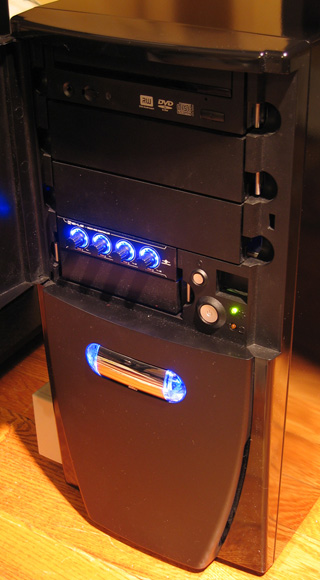
If this frame is too small for proper image viewing, please click here to fix the problem.
aLPHA tHREE

If this frame is too small for proper image viewing, please click here to fix
the problem.
Alpha Three is a work
system; although concessions have been made to reduce the noise
output from this system, reliability came first in its
development, followed my a focus on optimizing subsystems specifically for
dealing with my line of work, professional desktop publication and digital
imaging. The old NgTech Labs archives outline a history of Alpha line,
from back when it was more of an overclock gaming rig.
That page was in dire need of updating, so the
old site and its layout along with its (admittedly, severely outdated) images
has been dumped in favor of this major revamp, what with the development of an
entire new system with its new focus.
Among the special focuses were the graphics subsystem, which
is critical for desktop publication/digital imaging, and also on the storage
subsystem. Unlike in Sigma One, where the hard drive was chosen for its
acoustic performance as well as thermal characteristics, this system's two
storage subsystems were set up from the very root to reduce the hard drive
bottleneck to the very minimum, a critical factor when you're working, for
example, with 16-bits/channel, high-resolution (300-2400dpi), four-channel (CMYK)
images, which are often over 300MB in size. To deal with these massive A/V
requirements (this system also acts as my DVD ripping/encoding/burning system),
I assembled a multiway RAID-0 array using Maxtor's highly A/V-oriented Diamond
Max Plus 9 series drives. Because a RAID array of long-access time ATA
drives is not exactly the ideal environment for installing and running your OS
and application software from, I acquired a bootable LSI Logic Ultra 160 SCSI
host adapter, which Windows XP supports natively, and attached Seagate's blazing
fast Cheetah 15K.3 series drive to it.
The other critical focal point for my line of work, as I
said, is the graphics subsystem. Unlike in gaming, where the focus is on
pure speed as well as having an up-to-date, complete feature set (DirectX and
OpenGL support), digital imaging relies on high resolutions at high refresh
rates, maintained at the most stable and sharp condition possible (consumer
level gaming cards tend to utilize cheaper filtering components, resulting in
image blurring as refresh rates and resolutions go up); clearly, the Sapphire
Radeon 9800 I was utilizing before was not up to the task! I replaced it
with a true professional card designed for getting work done, a Matrox
Millennium G550; the Radeon now serves heavy duty in Gamma Two, my new gaming
rig. While I considered the Parhelia, I felt that the little G550 served
all the needs I had, without costing me an arm and a leg, since I did not have
any real need for the Parhelia engine's advanced 3D capabilities, being that my
line of work is pure 2D.
Clicking on certain images on this page
will also bring the page up in its own window,
starting right at the larger version of the clicked image (this only works for
images that have larger versions).
NgTechnik Design Alpha Three System Specifications:
System Foundation:
Enclosure: Antec Sonata
with Globe 120mm thermal-control exhaust fan mounted via ear
grommets
Power Supply Unit:
"Special" Antec TruePower 380 modified with AcoustiFan AF80CT for
cooling
System Mainboard:
ASUStek P4P800 nonDeluxe
Noise Reduction: System Exhaust and SCSI HDD Cooler attached to black Vantec Nexus NXP-205
Processing Subsystem:
Central Processing Unit:
Intel Pentium 4 2.6C processor
Central Processor Performance Configuration:
13.0x multiplier * 240.1MHz Front Side Bus Rate = 3120.9MHz
Core Rate
Central Processor Running
Configuration: 1.872Volts
Central Processor Cooling:
Thermalright SP-94, Arctic Silver V, AcoustiProducts 92mm Acoustifan AF92CT
Graphics Subsystem:
Graphics Acceleration Adapter: Matrox Millennium G550
Display Unit: Beige NEC
MultiSync FE1250+ 21" CRT
System Memory Subsystem:
Random Access Memory: Two
pieces of 512MB PNY Verto PC3500 Double Data Rate SDRAM (1GB total)
RAM Performance Configuration:
Dual-Channel, 5:4 Ratio, DDR384.2 with timings of 7-2-3 and 2.0 CAS
Latency
RAM Running Configuration:
2.75Volts
Mass Storage Subsystem:
Operating System and Applications:
Controller:
LSI Logic LSIU160 PCI Ultra160 LVD SCSI controller with native Windows XP
drivers
Hard Disk
Drive Unit: Single Seagate Cheetah ST318453LW Ultra320 LVD SCSI drive,
17.0GB formatted capacity @ 15000rpm
HDD Cooling:
Zalman ZM-2HC1 heatpipe cooler with rubber isolated mounting, Vantec HDC-502A
heatsink and active cooler
Audio/Visual & Documents/Downloads
Archiving and System Operating Cache:
Controller:
Promise FastTrak S150 TX4 PCI Four-Channel Native-SATA RAID controller
Hard Disk
Drive Units: Triple Maxtor Diamond MAX Plus 9 series 6Y060L0
UATA-133 drives, 60GB at 7200rpm each
RAID
Configuration: Three-Way, 64KB-Striping, 229GB total NTFS formatted
capacity
Running
Configuration: Drives connected to SATA RAID controller through ABIT Serillel SATA->PATA convertors
Optical Media Storage: Black Plextor PX-708A
Alternate Subsystems: Utilizing onboard 3Com Gigabit ethernet controller 3C940
Behold the pictures!
Here's a shot of the system
interior.
It has been lined with, "egg crate," foam along
the right side panel, the floor, part of the rear panel,
underneath the 3.5" drive cage and at the base of the 5.25" bay.
You can also clearly see the way the stock Antec case fan has been
remounted to the Zalman fan bracket to cool the VRAM and the northbridge.
Here is a much closer view of just
the case interior.
The PATA->SATA adapters are shown to the right,
the ZM-2HC1 cooler for the SCSI drive is visible
and the two AcoustiFans are visible as well.
This is a shot from the rear side of
Alpha Three.
The exhaust grill was cut out using tin snips;
it will be lined later to prevent injury.
I removed two of the half-height bay
fascias in order to shoot this nice picture.
With the illumination of the blue LEDs in the Vantec Nexus NXP-205,
you can see, not just its components, but also the HDC-502A
that cools the Cheetah from underneath. Nice?
Please point all comments and inquiries to Edward Ng.